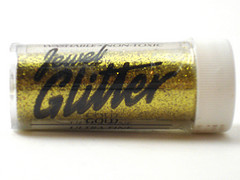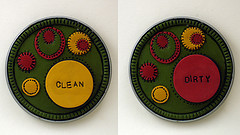Garage Sales & Glitter Giveaway
Miss me? Seems like I've been working day & night lately -- preparing for, executing & recovering from this past weekend's garage sale. All that stuff from my craft room clean-up had to go somewhere!
As I was sorting through & pricing items, I noticed some of the bottles of glitter I'd finally decided to get rid of. I've never been a big fan of glitter. Hubby & I specifically avoid buying glittery cards for each other. And if well-intentioned family members send such cards our way, we handle them by the corners, carefully, hoping to avoid any glitter "contamination." I have no idea, then, why I had several bottles of glittery stuff in my craft supplies.
One of the worst things about glitter, in my book, is that it sneaks into unbaked clay. Even in my mostly glitter-free house, I still manage to find specks now & then. And for some reason, they're completely invisible til after baking -- when suddenly that one little speck of glitter is all you can see! So I was a little surprised to find out at a recent polymer clay guild meeting that many of my fellow guild members are pro-glitter.
Apparently this whole glitter thing has become a big issue in the crafting world -- all in good fun, of course. Ellen DeGeneres wants to ban it. Crafters have staged pro-glitter rallies. It's election year, after all. We gotta debate the issues.
Do you love glitter or hate it?
Leave a comment letting me know how you feel. I'll randomly select two winners (one pro- & one anti-) to receive the items listed below (note: all supplies have been opened, but are almost completely full). One comment per person, please. Deadline is 11:59 p.m. CT on Saturday, May 3.
 Pro-glitter prize:
Pro-glitter prize:
- Scribbles Glittering Golden Copper Fabric Writer
- Stamp-n Stuff Copper Embossing Tinsel
- Gold Ultra Fine Jewel Glitter
- Ancient Gold Embossing Powder in Gilded Gold & Enchanted Gold.
 Anti-glitter prize:
Anti-glitter prize:
- Embossing Powder in Liquid Platinum, California Stucco, Cement & Gold
- Pearl Ex Super Copper pigment
(This is assuming the anti-glitter winner is okay with embossing powders, Pearl Ex powders, & other powdery shiny things that are not glitter. If not, I'll find something else from my craft stash to offer.)
Check back after the deadline for the results of this little informal poll, plus the names of the winners. Good luck!





































